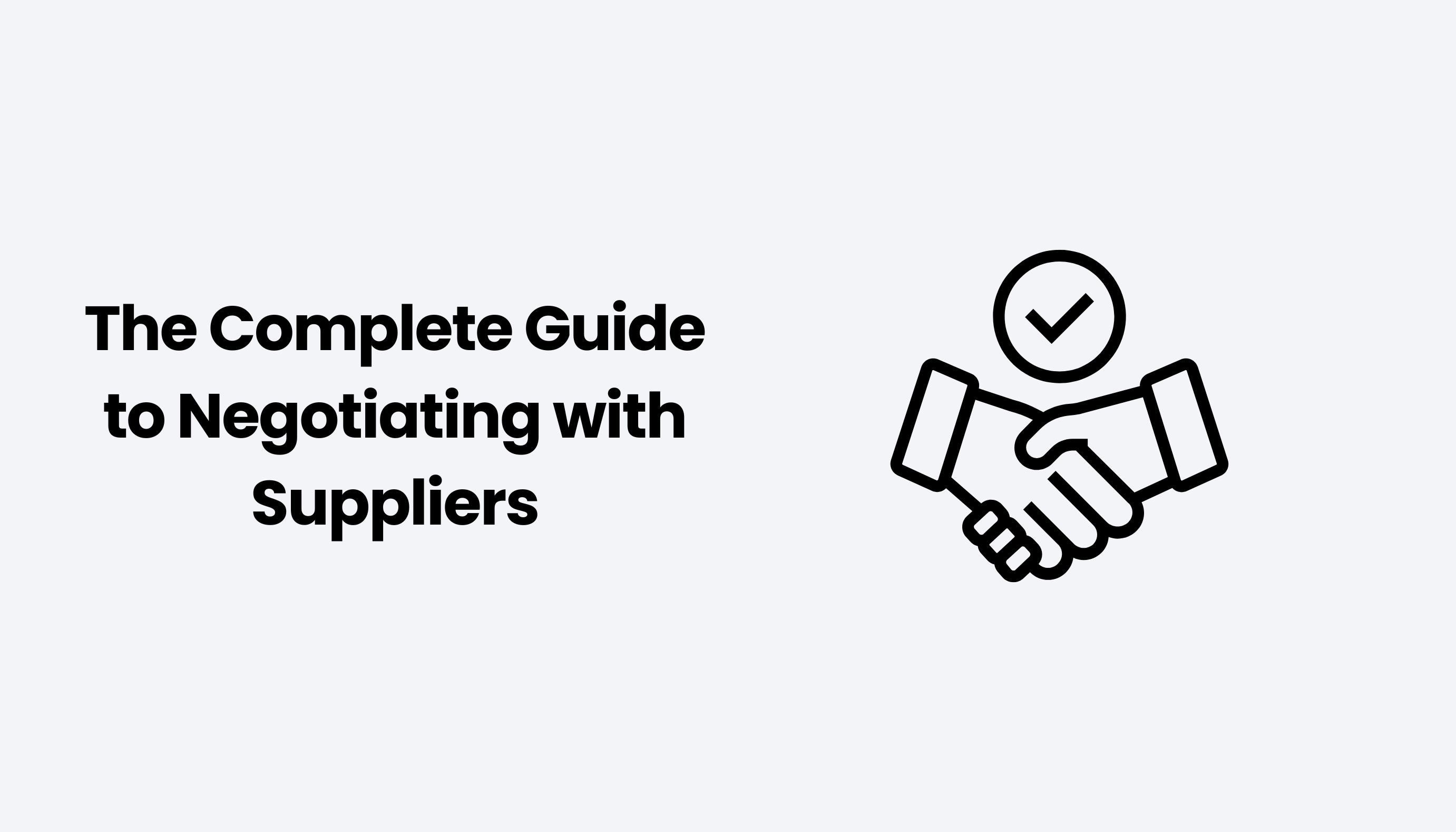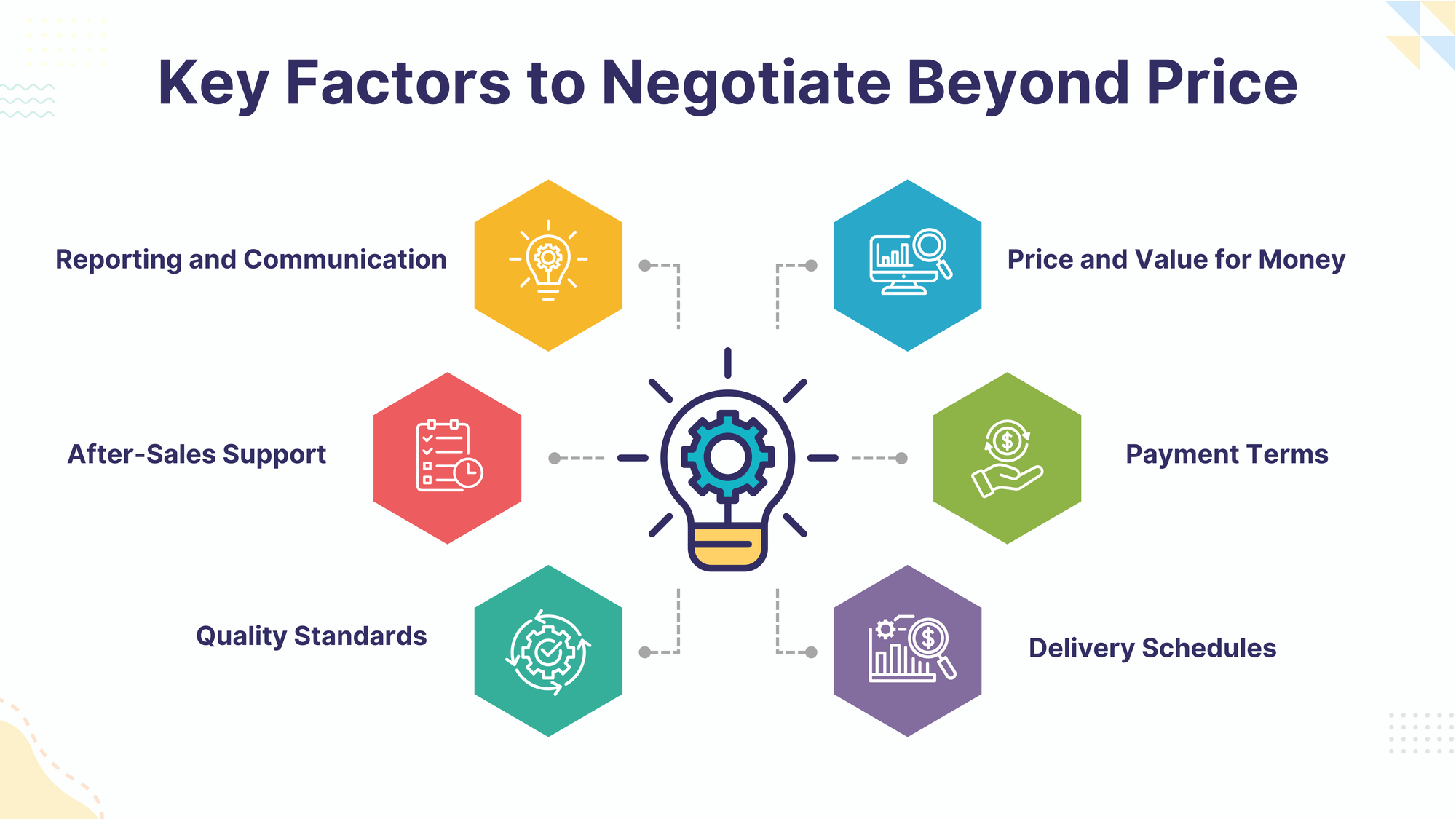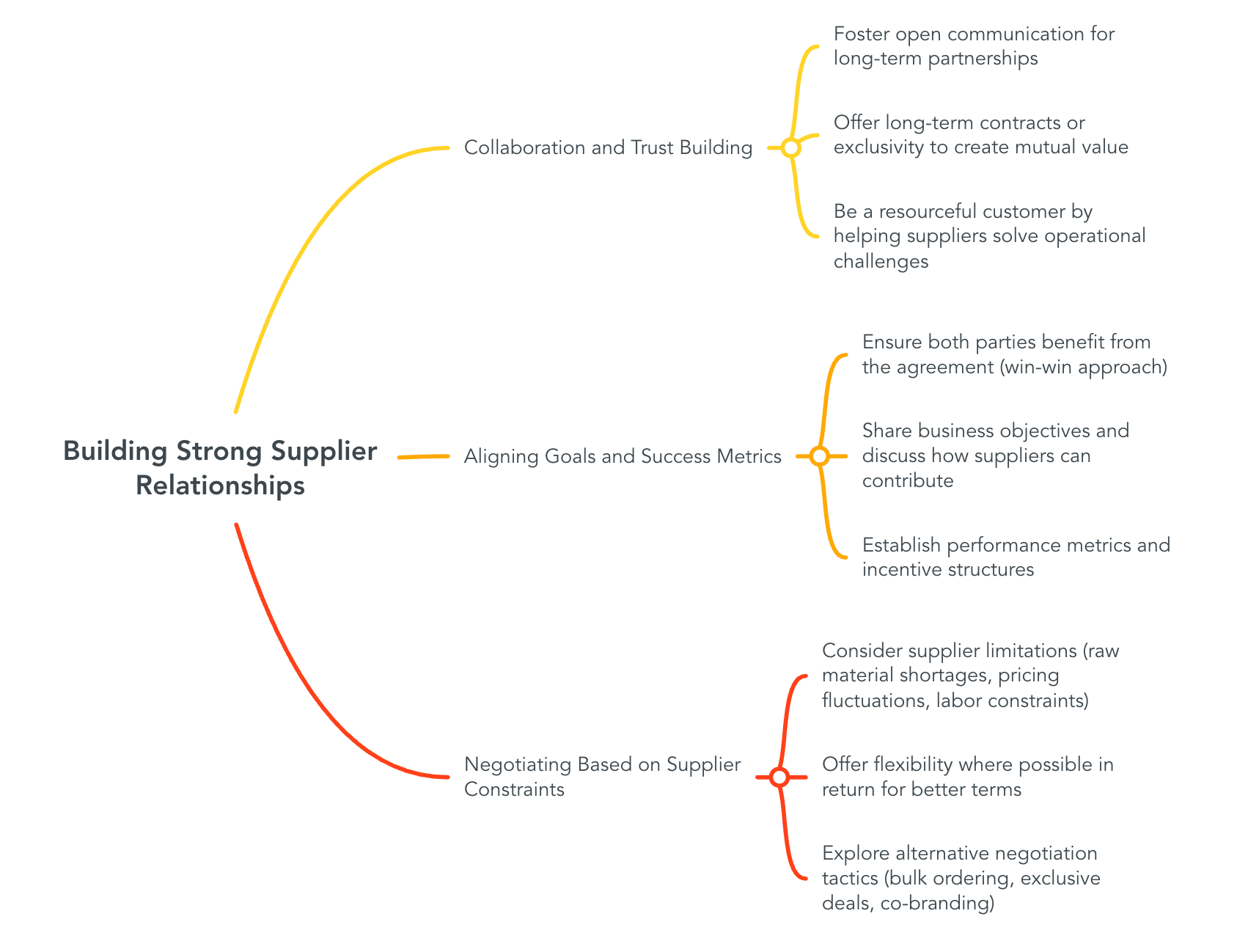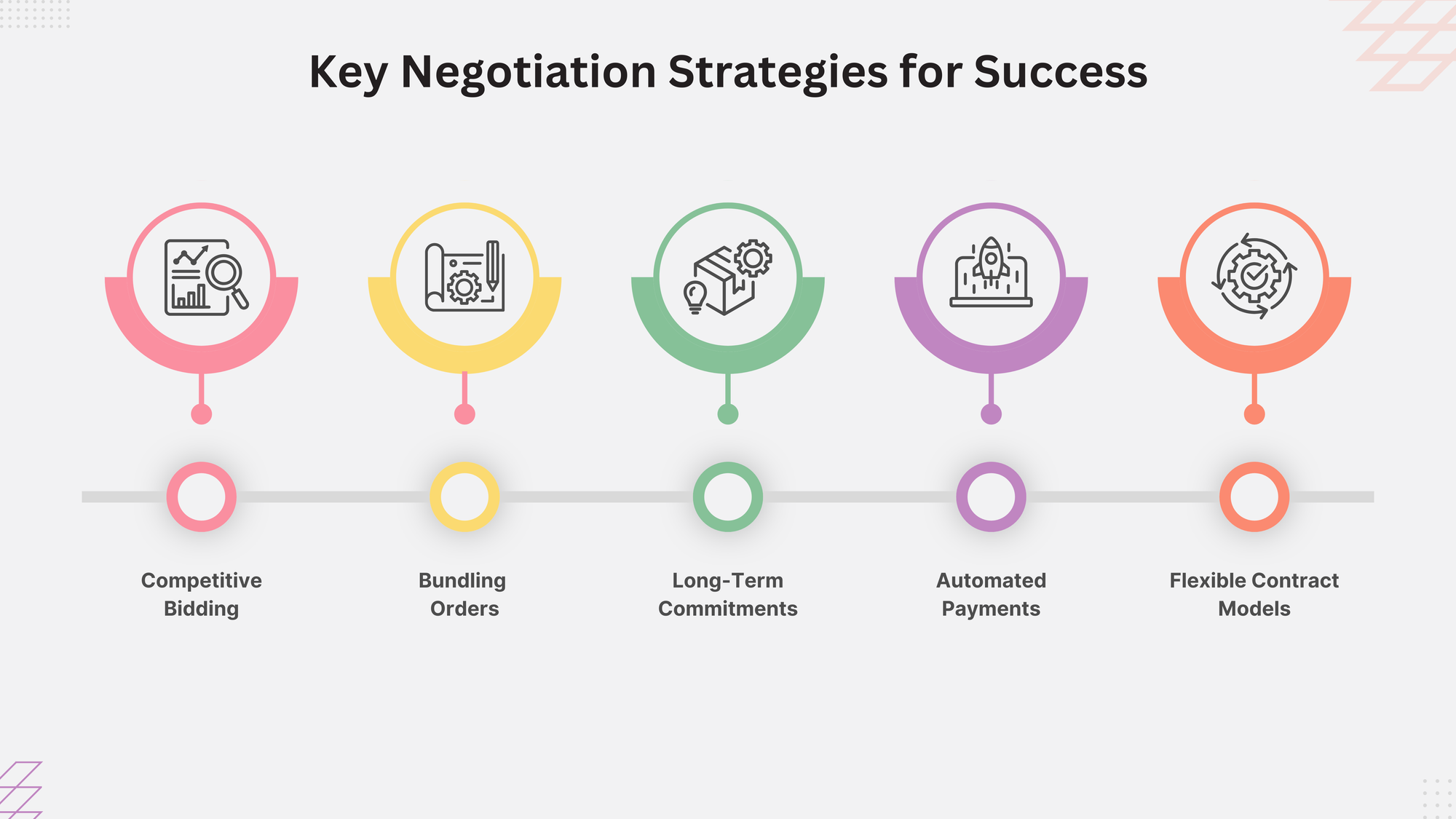The Complete Guide to Negotiating with Suppliers

Negotiating with suppliers is a crucial skill that directly impacts business profitability, supply chain efficiency, and product quality. Whether securing better pricing, improving payment terms, or ensuring timely deliveries, successful negotiations create long-term value for both buyers and suppliers. A well-structured approach—grounded in research, strategic communication, and relationship-building—can lead to favorable terms without compromising quality or reliability.
This guide provides a comprehensive roadmap for supplier negotiations, covering everything from preparation and strategy to contract finalization and long-term relationship management.
Table of Contents:
- Preparing for Supplier Negotiations
- Building Strong Supplier Relationships
- Negotiation Strategies and Techniques
- Closing the Negotiation and Finalizing Agreements
- Post-Negotiation Relationship Management
- Advanced Procurement Strategies
Jump to a section that interests you, or keep reading.
Preparing for Supplier Negotiations
Research and Market Analysis
A well-informed negotiation begins with a thorough market analysis. Understanding industry pricing structures and cost breakdowns allows businesses to enter discussions with realistic expectations. Suppliers operate with different margins, and knowing the market average for specific goods or services prevents overpayment.
Competitive research is equally crucial. Analyzing competitors’ supplier relationships and pricing models provides benchmarks for negotiations. If a competitor has secured more favorable terms, businesses can use this as leverage to seek similar or better deals.
Diversifying supplier options ensures flexibility. No vendor should be viewed as irreplaceable—evaluating alternative suppliers helps mitigate risks tied to reliance on a single source. By identifying multiple vendors, businesses can negotiate from a position of strength, ensuring they are not locked into unfavorable agreements due to limited choices.
Understanding Supplier’s Business and Goals
Suppliers have their own operational challenges, and understanding them can create mutually beneficial agreements. Studying a vendor’s business model, cost structure, and constraints helps in identifying areas where both parties can find alignment. If a supplier struggles with demand fluctuations, offering long-term contracts may lead to better pricing and priority service.
Suppliers prioritize stability, profitability, and volume-based agreements. If a business can guarantee consistent orders, it strengthens its position during price discussions. Building leverage is not just about securing lower costs—it’s about creating value for both parties. Businesses that position themselves as valuable clients rather than transactional buyers gain more flexibility in negotiations.
Additionally, suppliers may face issues related to production capacity, raw material shortages, or logistics inefficiencies. Addressing these concerns—whether through flexible order scheduling or assistance in problem-solving—can lead to better cooperation. When vendors perceive a client as an asset rather than just a buyer, they are more likely to accommodate requests and extend preferential treatment.
Setting Clear Objectives for Negotiation
Clear, structured negotiation goals prevent ambiguity and ensure measurable outcomes. Using the SMART framework (Specific, Measurable, Achievable, Relevant, Time-bound) allows businesses to define exactly what they expect from supplier agreements. Instead of broadly demanding “better pricing,” a company should aim for a 5% cost reduction over a 12-month period based on increased order volume.
Negotiation extends beyond price. Several key factors should be addressed:

- Price and Value for Money – The lowest price is not always the best deal. Suppliers may compensate for discounts by reducing quality or service levels. Negotiations should focus on maintaining fair pricing while ensuring product reliability.
- Payment Terms – Structuring payments to benefit both parties can improve cash flow. Options like early payment discounts, extended payment periods, and automated invoicing can enhance financial flexibility.
- Delivery Schedules – Reliable supply chains depend on consistent delivery. Clear agreements on on-time delivery commitments and penalties for delays create accountability.
- Quality Standards – A well-defined quality benchmark prevents disputes over subpar materials. Setting specific performance expectations ensures supplier accountability.
- After-Sales Support – Vendor responsibility does not end at delivery. Terms related to warranties, returns, and dispute resolution safeguard businesses against defective products or service failures.
- Reporting and Communication – Transparency strengthens partnerships. Establishing clear reporting structures, regular meetings, and open communication ensures both parties stay aligned.
Building Strong Supplier Relationships

Collaboration and Trust Building
Strong supplier relationships rely on open communication and mutual benefit. Transparency about business needs, challenges, and expectations fosters trust, making vendors more willing to offer favorable terms, priority service, and flexible agreements. Instead of transactional engagements, businesses should focus on long-term partnerships that provide stability for both parties.
Offering long-term contracts or exclusivity agreements can create additional value for suppliers. Committing to consistent orders reduces their uncertainty, which can lead to better pricing, improved service, and priority production slots. In industries with volatile pricing or fluctuating demand, exclusive deals ensure consistent supply chain reliability while giving businesses a competitive edge.
Beyond financial negotiations, businesses that position themselves as resourceful customers gain more goodwill from suppliers. Vendors face their own operational challenges—whether it’s logistics bottlenecks, regulatory hurdles, or production inefficiencies—and helping them solve these issues fosters stronger ties. A business that provides valuable insights or connects a vendor with new distribution channels, financing options, or process improvements enhances its position as a preferred client.
Aligning Goals and Success Metrics
A negotiation should not be a one-sided gain. Both parties must see tangible benefits to sustain long-term collaboration. Aligning supplier agreements with shared goals creates a foundation where vendors are invested in a company’s success, leading to better responsiveness, improved service, and consistent quality.
Setting clear business objectives at the start of a supplier relationship ensures that expectations are aligned. Businesses should discuss growth plans, expansion strategies, and market positioning to help suppliers understand their role in achieving these goals. In return, vendors can offer more tailored pricing models, volume-based incentives, and flexible delivery schedules that align with business cycles.
Performance metrics ensure that agreements are upheld. Businesses should establish key benchmarks such as on-time delivery rates, defect rates, response times, and customer satisfaction scores. Suppliers who consistently meet or exceed these metrics can be rewarded with extended contracts, volume increases, or premium partnerships, reinforcing a mutually beneficial dynamic.
Incentive structures encourage continuous improvement. Offering bonus payments for exceptional performance, profit-sharing models, or future contract guarantees motivates suppliers to maintain high standards. A well-structured incentive model ensures vendors remain engaged and committed to delivering value beyond basic contractual obligations.
Negotiating Based on Supplier Constraints
Suppliers operate within their own limitations, and understanding these constraints allows businesses to negotiate more practical and sustainable agreements. Raw material shortages, production costs, labor challenges, and supply chain disruptions can impact a vendor’s ability to deliver as expected. A rigid negotiation approach that ignores these factors may lead to unreliable supply chains and strained relationships.
Offering flexibility in return for better terms can be an effective strategy. If a supplier struggles with seasonal production constraints, businesses can adjust order schedules to accommodate peak and low periods. Similarly, when raw material prices fluctuate, companies can explore cost-sharing mechanisms or pricing models that adjust based on market conditions to maintain fairness for both parties.
Alternative negotiation tactics can unlock additional value. Bulk ordering agreements secure lower per-unit costs while ensuring suppliers have guaranteed business. Exclusive deals can incentivize suppliers to prioritize a business over competitors, offering faster delivery times, premium materials, or custom solutions. In some cases, co-branding or collaborative marketing can add further value by enhancing the supplier’s market visibility while reinforcing a company’s brand credibility.
Negotiation Strategies and Techniques
The Art of Persuasion in Negotiations
-
Building Rapport: Establishing trust before discussing pricing fosters a collaborative relationship. Suppliers are more receptive when they perceive negotiations as partnerships rather than transactions. Engaging in open conversations about their business challenges and priorities helps create a foundation for constructive discussions.
-
Using Data and Market Insights: Backing negotiation requests with factual data enhances credibility. Conducting thorough research on industry pricing trends, competitor agreements, and supplier cost structures allows for well-supported arguments. Presenting cost comparisons, projected order volumes, or alternative supplier offers can justify lower pricing and improved service terms.
-
Active Listening: Understanding supplier constraints, such as rising raw material costs, production limitations, or logistical hurdles, provides opportunities to structure agreements that benefit both parties. A responsive approach reassures suppliers that their concerns are acknowledged, fostering goodwill and making them more likely to accommodate requests.
Key Negotiation Strategies for Success

-
Competitive Bidding: Requesting quotes from multiple suppliers increases bargaining power. When suppliers recognize competition, they are more likely to adjust pricing, enhance service levels, or offer additional incentives. Ensuring transparency about market options can lead to better financial terms without compromising quality or reliability.
-
Bundling Orders: Negotiating discounts for bulk purchases reduces per-unit costs. Consolidating orders across multiple product categories or committing to larger quantities gives suppliers the advantage of predictable demand, lower transaction costs, and operational efficiencies, making them more inclined to offer incentives.
-
Long-Term Commitments: Extending contract duration in exchange for better pricing provides stability for both parties. Multi-year agreements, minimum order guarantees, or exclusive partnerships often lead to lower costs, priority service, and added benefits like dedicated account management or preferential production scheduling.
-
Automated Payments: Proposing automated invoicing or scheduled payments improves cash flow predictability for suppliers. Reliable payment processing builds trust, which can result in better terms, discounts, or extended credit options. Ensuring suppliers receive timely payments also strengthens long-term relationships.
-
Flexible Contract Models: Exploring alternative pricing structures, such as profit-sharing arrangements, performance-based incentives, or volume-based pricing, can lead to more favorable agreements. Aligning supplier incentives with business objectives ensures both parties benefit from cost savings and operational efficiencies.
Overcoming Common Supplier Objections
-
Handling Price Resistance: Shifting discussions from price alone to overall value can address supplier concerns. Highlighting guaranteed order volumes, reduced administrative burdens, or marketing collaborations can make lower pricing more attractive by presenting long-term business benefits.
-
Managing Pushback on Contract Terms: Suppliers may resist specific conditions, requiring strategic compromises. If extended payment terms are declined, negotiating additional service commitments, quality assurances, or flexible delivery schedules can provide alternative ways to balance the agreement.
-
Addressing Delivery Concerns: Flexibility in scheduling can mitigate supplier challenges. If tight timelines are difficult to meet, staggered shipments, adjusted lead times, or alternative fulfillment schedules can help maintain reliable supply chain operations without sacrificing efficiency.
Closing the Negotiation and Finalizing Agreements
Drafting a Strong Supplier Contract
-
Agreed Pricing and Discount Structures: Clearly defining pricing terms prevents misunderstandings. The contract should specify unit prices, volume-based discounts, and any applicable promotional offers. Stipulating conditions for future price adjustments ensures transparency in case of market fluctuations.
-
Payment Terms and Late Payment Penalties: Outlining payment conditions, such as due dates, accepted payment methods, and early payment discounts, ensures financial predictability for both parties. Including penalties for late payments discourages delays and protects suppliers from cash flow disruptions.
-
Quality Control Measures and Rejection Policies: Establishing measurable quality benchmarks ensures consistency. The contract should detail product specifications, acceptable tolerances, and inspection procedures. A structured rejection policy clarifies the process for handling defective goods, replacement timelines, and financial accountability.
-
Liability Clauses and Risk-Sharing Mechanisms: Addressing potential liabilities minimizes disputes. The agreement should define responsibility for damages, delays, or defective products. Allocating risk through indemnity clauses or shared liability provisions ensures both parties uphold their commitments.
-
Dispute Resolution Frameworks: Predefining conflict resolution methods prevents prolonged disputes. Including mediation, arbitration, or jurisdiction-specific legal frameworks ensures a structured approach to resolving disagreements. Stating clear escalation procedures improves communication and maintains business continuity.
Ensuring a Smooth Transition
-
Conducting Trial Orders: Testing supplier performance before full-scale implementation reduces operational risks. Limited initial orders allow businesses to assess product quality, adherence to delivery timelines, and overall service reliability before committing to larger purchases.
-
Establishing a Feedback Loop: Regular performance reviews ensure continuous improvement. Implementing structured reporting systems, periodic check-ins, or automated tracking tools enables proactive issue resolution and enhances supplier accountability. Open communication fosters a collaborative relationship and minimizes disruptions.
-
Setting Up Periodic Contract Reviews: Market conditions and business needs evolve, necessitating contract adjustments. Scheduling periodic evaluations ensures agreements remain aligned with expectations. Renegotiating pricing, updating service levels, or adjusting delivery schedules keeps the relationship efficient and mutually beneficial.
Post-Negotiation Relationship Management
Monitoring Supplier Performance
-
Tracking KPIs: Establishing key performance indicators ensures suppliers meet expectations. Metrics such as delivery punctuality, product quality, defect rates, and response time for issue resolution provide objective benchmarks. Monitoring these consistently helps identify trends and potential areas of concern.
-
Regular Performance Reviews and Feedback Sessions: Periodic evaluations keep suppliers accountable. Structured meetings allow for discussions on performance metrics, challenges, and improvement opportunities. Addressing concerns proactively prevents small issues from escalating and reinforces a culture of continuous improvement.
-
Implementing Corrective Actions for Underperformance: When suppliers fail to meet expectations, immediate corrective measures are necessary. Revising service-level agreements, setting improvement deadlines, or adjusting order volumes based on performance ensures accountability. Collaborating on solutions rather than imposing penalties strengthens relationships while maintaining standards.
Strengthening Long-Term Supplier Relationships
-
Offering Incentives for Continuous Improvement: Encouraging suppliers to enhance efficiency and quality through structured incentives fosters mutual growth. Volume-based rewards, preferred vendor status, or extended contracts for superior performance create motivation for ongoing excellence.
-
Providing Transparent Communication on Changing Business Needs: Keeping suppliers informed about shifts in demand, product specifications, or operational adjustments prevents disruptions. A clear flow of information ensures they can adapt to new requirements, align production schedules, and maintain service levels.
-
Recognizing Supplier Contributions and Fostering Goodwill: Acknowledging supplier efforts strengthens partnerships. Public recognition, testimonials, or preferential treatment for consistent performance encourage loyalty. Maintaining a collaborative approach rather than a purely transactional one builds trust and long-term stability.
Advanced Procurement Strategies
Using AI and Data Analytics for Procurement Insights
Leveraging AI-driven procurement tools enhances decision-making by analyzing historical purchasing patterns, market trends, and supplier performance data. Predictive analytics helps businesses anticipate price fluctuations, identify cost-saving opportunities, and optimize purchasing schedules. AI also streamlines supplier selection by evaluating risk factors, lead times, and compliance metrics, ensuring businesses engage with the most reliable partners.
Implementing Supplier Risk Management Frameworks
A structured approach to supplier risk management minimizes disruptions and ensures supply chain resilience. Businesses must assess financial stability, geopolitical risks, and operational dependencies of suppliers. Diversifying the supplier base, establishing contingency plans, and conducting periodic risk audits safeguard against unexpected disruptions. Supplier scorecards and risk assessment models provide a structured evaluation method, allowing businesses to proactively address vulnerabilities before they impact operations.
Exploring Digital Contract Management Tools for Better Negotiation Tracking
Digital contract management platforms streamline procurement by centralizing agreements, tracking negotiation history, and automating compliance monitoring. These tools provide real-time visibility into contract terms, renewal deadlines, and performance benchmarks, reducing the risk of disputes and missed obligations. Automated alerts ensure timely renegotiations, while AI-powered analytics identify opportunities for cost reductions and supplier optimization. Standardizing contract management improves efficiency, enhances transparency, and strengthens supplier relationships through well-documented agreements.
Conclusion
Mastering supplier negotiations goes beyond securing the lowest price—it’s about creating partnerships that foster reliability, efficiency, and long-term growth. A strategic approach that includes thorough research, clear objectives, effective persuasion techniques, and structured contract management ensures sustainable agreements that benefit both parties.
Beyond the negotiation table, ongoing supplier relationship management is key to maintaining performance, mitigating risks, and adapting to changing business needs. By continuously monitoring supplier performance, leveraging digital procurement tools, and refining strategies over time, businesses can build a resilient and competitive supply chain.
A well-negotiated supplier agreement doesn’t just reduce costs—it enhances operational stability, improves product quality, and positions a company for long-term success in an increasingly complex market.
